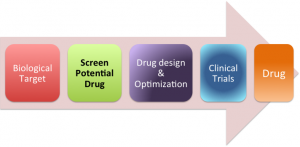Welcome to the Structural Biology and Biophysical Chemistry (SBBC) laboratory at NYUAD with research interests that lies at the intersection between biochemical and biophysical sciences. Our research focuses on the characterization of proteins’ structures and mechanisms using X-ray crystallography and a verity of different biophysical and biochemical techniques. Different biological macromolecules are under investigation to be used as targets in the discovery and rationale drug design of new therapeutics or to characterize a unique biological phenomenon. The SBBC laboratory also aims to promote structural biology and protein chemistry in the United Arab Emirates through research and core facility collaboration.
Research in the SBBC laboratory is in the area of protein chemistry with emphasis on molecular and structural characterization of the protein’s biological function. Multiple modern experimental approaches are used as means to characterize the proteins’ molecular mechanisms with emphasis on proteins with therapeutic relevance to diseases such as cancer and cystic fibrosis. Characterization of the disease mechanism will be further used in the design and development of new therapeutics with higher specificity to the biological target but with minimal side effects. In addition, we are investigating the reaction mechanism of enzymes involved in bioluminescence to elucidate their reaction mechanism in producing different colors of light.
High-Throughput Screening and Structure Based Drug Design are used as a combined approach for a fast and efficient discovery of new therapeutics for the treatment of cancer and cystic fibrosis. Proteins with therapeutic relevance to cancer (human Hexokinase 2) or cystic fibrosis (CFTR; Cystic fibrosis transmembrane conductance regulator) are used as biological targets for the discovery of a novel class of therapeutics. High-throughput screening of a small molecules library against the protein target for the discovery of lead compounds that inhibit the proteins’ disease causing mechanism is used in the development of new therapeutics with high efficacy. The lead compounds from the screen will be further developed using Structure Based Drug Design, where the protein structural information along with computer simulations will guide the development of the lead compound for enhanced therapeutic effect and binding specificity.

In 1931, Dr. Otto Heinrich Warburg was awarded the Nobel Prize in Physiology or Medicine for his discovery that cancerous cells can live and develop in the absence of oxygen at elevated rate of glucose metabolism; a phenotype detected clinically using Positron Emission Tomography (PET). The increase in the glycolytic rate enhances cancer cell proliferation and increases the local concentration of lactic acid, the end product of the glycolytic pathway that creates an unfavorable environment for the normal tissue. Hexokinase, the first enzyme of the glycolytic pathway catalyzes the phosphorylation of glucose to glucose-6-phosphate, is the gateway enzyme of glucose metabolism in the cell. Its irreversible reaction represents a rate-limiting step that is crucial in the regulation of cellular sugar metabolism.
Read More
Cystic fibrosis (CF) is the most prevalent genetic condition in the Caucasian population that is caused by the impaired functional expression of a trans-membrane chloride ion channel, Cystic Fibrosis Trans-membrane conductance Regulator (CFTR). The defective channel retards salt and water transport at the apical membrane of epithelial cells. CFTR is a multi-domain integral membrane protein that belongs to the ABC transporter super-family.
Read More
Bioluminescence, the emission of light from a biological process without releasing heat, is found in various living organisms including bacteria, fireflies, beetles, fungus and different marine organisms. Luciferase is an enzyme that catalyzes a bioluminescent reaction by the oxidation of luciferin, in the presence of Mg2+ and ATP, to oxyluciferin and releases energy in the form of light.
Read More
We use X-ray crystallography to determine the 3D structures of protein molecules. The lab is equipped for all aspects of protein expression, purification, and crystallization including the following instruments:
- FPLC System: ÄKTA explorer 100 Air, from GE Healthcare Life Sciences
Instruments
- Bravo Automated Liquid Handling Platform from Agilent
Instruments
- Honeybee Microarrayer for Protein Crystallography from Digilab
Instruments
The robots are used for the high-throughput screening of crystallization conditions that will yield protein crystals for the collection of high-resolution X-ray data sets at different synchrotron radiation facilities worldwide.
